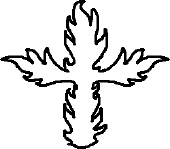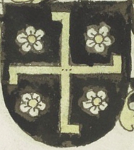Note: Submissions and commentary on crosses of this type have also used the terms "formy convex", "formy convexed", and "patty convex".
a roundel bearing four semi-elliptical notches in saltire
Volume III of William Berry's 1828 Encyclopædia Heraldica, plate XXXII
"[This cross has] been documented only to within our 50-year 'grey area', and only as an artistic motif, not an heraldic charge. The only terms that adequately describe it are found in a 19th Century work, compiled by an author whose lack of scholarship is legend. I simply have no grounds for believing this cross to be compatible with period heraldic style." (March, 1993 LoAR)
There's no significant difference between a cross patty fitchy and a cross patty convex fitchy. (July, 1985 LoAR)
Cross of Cerdaña
an eqilateral lozenge with a semi-circular notch at the center of each of its sides

"This cross is an SCA-invented cross. It has never been documented to period. Barring evidence for the use of this cross as a period charge, we will cease to register these crosses after the August 2010 Laurel meeting." (cover letter to the February, 2010 LoAR)
Note: This cross is reminiscent of a cross clechy.
crosshair cross
a cross conjoined to and surmounted by an annulet
When throughout, this type of cross has also been blazoned as a Cross of Coldharbour.


Due to its association with white supremacist organizations, all forms of this cross are unregistrable regardless of documentation. (cover letter to the July, 2018 LoAR)
Whether it is still permitted to register an ordinary cross interlaced with an annulet despite its resemblance to this cross is not specified in the ruling that banned it. The registration of a cross potent throughout so interlaced is, however, explicitly permitted. (cover letter to the July, 2018 LoAR)
Note: This cross has a great deal in common with a Coptic cross. Some forms of it loosely resemble Celtic crosses.

Cross of Coldharbour
Or, a bend azure and overall a cross interlaced with an annulet argent.
BSB Cod.icon. 273, folio 48r
crosslet, with extra crossbars

". . .a cross crosslet is a cross couped with a crossbar on each of the four arms. The depicted cross takes this a fractal step further and adds another crossbar on each of the twelve branches. No documentation was presented, and none could be found, that this is a period style of cross." (January, 2010 LoAR)
cross enflamed
showing flames around the edges

Flaming crosses are no longer registered in the S.C.A., because of their association with the Ku Klux Klan. (Glossary of Terms)
A cross enflamed "would have small spurts of flame issuant from around the edge". (December, 2010 LoAR)
cross of flames
a cross made out of fire

Flaming crosses are no longer registered in the S.C.A., because of their association with the Ku Klux Klan. (Glossary of Terms)
"Without evidence that ordinaries of flame were used in period armory,or that such are compatible with period armory, we will not register ordinaries of flames." (February, 1994 LoAR)
Saint Florian Cross

"No evidence was provided, and none could be found, that the 'Saint Florian' cross is a period charge." (September, 2019 LoAR)
Note: This cross bears some similarity to a cross alisée.
fylfot cross
a cross potent missing the counter-clockwise end of the terminal crosspiece on each arm
In the gurgity variant, the remaining terminals are curved, so it more closely resembles a cross moline missing the counter-clockwise curl.
In heraldic contexts outside the S.C.A. this cross is sometimes blazoned a "cross potent rebated" or "cross gammadion".

Sable, a fylfot reversed Or between four roses argent.
fol. 220 Klassik Stiftung Weimar, seite 372

a cross gurgity
The fylfot is a restricted charge because of its strong association in the minds of most members of the Society with the Nationalsozialistische Deutsche Arbeiterpartei (the German Nazis of World War II). (Glossary of Terms)
The cross gurgity is a variant of a fylfot, and thus unregistrable in all its forms. (June, 2018 LoAR)
Note: No similar ruling has as yet been made on the cross potent rebated in annulo.
Latin cross with its vertical member shifted to dexter or sinister

arms of Pope John Paul II
detail from an image by Magul available under a GNU Free Documentation License
"Although [a cross enhanced to chief and to dexter] has been used in modern heraldry, we were unable to find any use of the extremely unbalanced design in period heraldry. This is just not 'period style'." (March, 1989, LoAR)
"[A cross enhanced to sinister chief] is inherently highly unbalanced, and no evidence was presented for its existence in period. The one example presented for a cross enhanced and offset this way is modern: the arms of Pope John Paul II, designed for him by Archbishop Bruno B. Heim when he became Archbishop of Krakow and later modified by changing tinctures when he was invested as Pope. These are clearly modern arms, and cannot be used as evidence for period style usage." (September, 1995 LoAR)
non-cross
a cross formy surmounted by two cartouches voided in cross

"Non-crosses are an SCA invention. . .no longer registerable barring evidence that such crosses are compatible with period style." (August, 2000 LoAR)
Papal cross
a Latin cross with three crossbars in chief

The Papal cross is restricted as a symbol of the Roman Catholic Pope. (Glossary of Terms)
"a cross pierced and patée and botonné"
Joseph Foster's 1902 Some Feudal Coats of Arms, page 18
"No documentation was provided that such a cross, which looks like a cross bottony with added flanges, was a reasonable variant of period crosses." (July, 1999 LoAR)
While there is some limited evidence that a cross of this type might have appeared in the 14th-century Falkirk roll, it is contradictory and inadequate. And even if the cross was seen there, that probably represents, "a one-off period weirdness". (August, 2000 LoAR)
Note: This cross does bear some similarity to a cross formy triply-pometty.

"No documentation was presented, and none was found, for the cross pattée concave in period armory. This cross has ends that are straight throughout most of their length, and flare out only at the very ends of the arm. As far as we are aware, period crosses formy flare out along the entirety of their length.
The term concave, as found in a few previous SCA registrations, appears to apply to a cross that is somewhat nowy lozengy (or nowy of a lozenge). This cross is only slightly nowy of a lozenge. Because the blazon term concave is not well-defined in real-world or SCA armory, it should be avoided in the future." (March, 2004 LoAR)
Red Cross cross

flag of the International Red Cross
this image is in the public domain because it consists entirely of information that is common property and contains no original authorship
Because the emblem of the International Red Cross is protected by international treaty, "The use of a red straight armed cross with flat, couped ends to the arms on any white background, or in any way that could be displayed on a white background, including as a tertiary charge, is prohibited, even if some of the arms are elongated so that it is not blazonable exactly as a cross couped gules". (January, 2009 LoAR) Neither an overall charge nor a tertiary charge placed on such a cross is sufficient to clear the conflict. (February, 2013 LoAR)
"The use of multiple gules crosses couped may be returned on a case-by-case basis if their placement or usage appears too evocative of the symbol of the Red Cross." (July, 2006 LoAR)"While a cross fitchy conflicts with a cross not fitchy, our protection of the Red Cross is not by conflict, but by presumption." (April, 2014 LoAR) As a blazonable difference, fitching is enough to eliminate presumption. (July, 2012 LoAR)
San Damiano cross
"a San Damiano crucifix with the body removed"
the San Damiano crucifix
this photo of an icon cross believed to have been painted some time before 1205 C.E. is in the public domain
". . .no documentation was presented for this being a period cross. Absent such documentation the charge is not registerable." (June, 1999 LoAR)
star-cross
Note: Outside the S.C.A., "star-cross" is sometimes used as the blazon for the charge that is blazoned a "cross estoile" in S.C.A. heraldry.
a pallet surmounted in chief by a saltorel

"The star-cross is a modern invention and not a period charge." (March, 1994 LoAR)
Ukranian sun cross
a cross swallowtailed nowy

"No documentation was provided that Ukrainian sun crosses were used as anything except an artistic motif in period. There are many artistic motifs that were never used in heraldry, even in areas that used heraldry. Therefore, being an artistic motif is insufficient.. . ." (November, 1999 LoAR)



